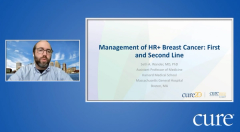
Educated Patient® Metastatic Breast Cancer Summit Addressing Therapeutic Resistance Presentation: November 12, 2022
Watch Dr. Dejan Juric, from Massachusetts General Hospital, discuss therapeutic resistance during the CURE Educated Patient Metastatic Breast Cancer Summit.
Input from patients with breast cancer is critical for clinicians to understand both drug resistance (reduced effectiveness of a treatment for a disease) and sensitivity (how the body reacts to a specific treatment), according to an expert.
Dr. Dejan Juric, an oncologist at the Center for Breast Cancer and director of the Termeer Center for Targeted Therapies at Massachusetts General Hospital in Boston, explained how this is also assessed throughout the drug development process during the CURE® Educated Patient® Metastatic Breast Cancer Summit.
“There’s no way for us to understand drug resistance without partnership with patients,” he said. “A lot of things that we do to understand drug resistance cannot be done to patients. They have to be done together with patients, and normally then we have even a chance to understand this phenomenon.”
During the process of drug development, researchers focus on both sensitivity and resistance to treatment. Through this, researchers aim to find new agents that can overcome resistance or new combinations of therapies that are able to interact with existing drugs to improve their ability to kill tumors that are increasingly more resistant and refractory to standard treatment.
Towards the beginning of the timeline for drug development, lots of work is initially done in laboratories, which can take several years. This involves researchers determining which disease, target or biomarker to focus on with a given therapy. Once that is completed, findings are submitted to the Food and Drug Administration (FDA) and, if the application is approved, phase 1/2 trials can begin. Also known as first-in-human trials, this is when researchers can treat the first patient with the therapy.
“Their goal is to understand the dose, the safety profile, pharmacokinetic and pharmacodynamic features of the drug, and ultimately, activity of the drug,” Juric said. “We often forget that it is now 2022, (and it’s) really, really important to see activity — tumor killing or tumor shrinkage — even from those very early investigations, the very first clinical trials.”
Once researchers determine that there is activity with the therapy and it is in a safe manner, phase 2 and 3 trials can begin, which often support an application for regulatory approval by the FDA. In particular, phase 3 trials assess whether a specific treatment works compared to standard-of-care therapy.
Throughout this entire drug development process, researchers are determining what makes a tumor sensitive or resistant to a therapy. Juric discussed a “TBD” of drug development: what is the target; is there a biomarker; and what is the disease of interest?
“A lot of work in the preclinical setting to try to understand sensitivity resistance is actually focused on figuring out which disease, which context will provide the best opportunity for the treatment to work,” Juric said. “This is a really fascinating area of research. Treatments can be developed in a disease agnostic way. In other words, a mutation or a target is important and can be interfered with regardless of the context.”
There are several therapies approved by the FDA that are not for one specific cancer type, Juric said. For example, NTRK fusion is a very rare alteration that’s present in secretory breast cancer, a very rare type of breast cancer, he explained. Drugs that work for this specific genetic alteration has been shown to be effective in patients with other cancers regardless of where it originated in the body.
“To go back to these fundamentals, it is a (target) and a (biomarker) indeed that really needs to be determined before we can understand anything about the actions of drugs, resistance or sensitivity,” Juric said.
Once these factors are determined, researchers go through a systematic process — almost like detective work —including clinical investigations and translational research with the patient. This includes testing a hypothesis, seeing if the drug is (working) and whether it has a clinical effect. Lastly, researchers try to determine what accounts for the variable effect. This process is repeated over and over to learn more about the drug being developed.
Juric noted that throughout this process, researchers focus on intrinsic resistance, or when the treatment doesn’t have an impact of any kind on the tumor. There is also acquired resistance, when a tumor initially shrinks in response to treatment, and symptoms and radiographic features of disease improve and then the disease starts growing again.
“This truly becomes a journey of both the patient and the drug,” Juric said. “And if you do it well first, there are no negative trials. You're constantly learning something about the disease that the patient has, and the drugs that you’re trying to develop for these refractory tumors. And if you do it really systematically, sooner or later, you find the key. And you can actually get the drug that checks off all the boxes along this continuum.”
For more news on cancer updates, research and education, don’t forget to













